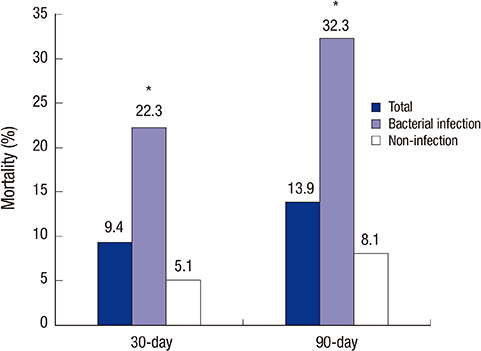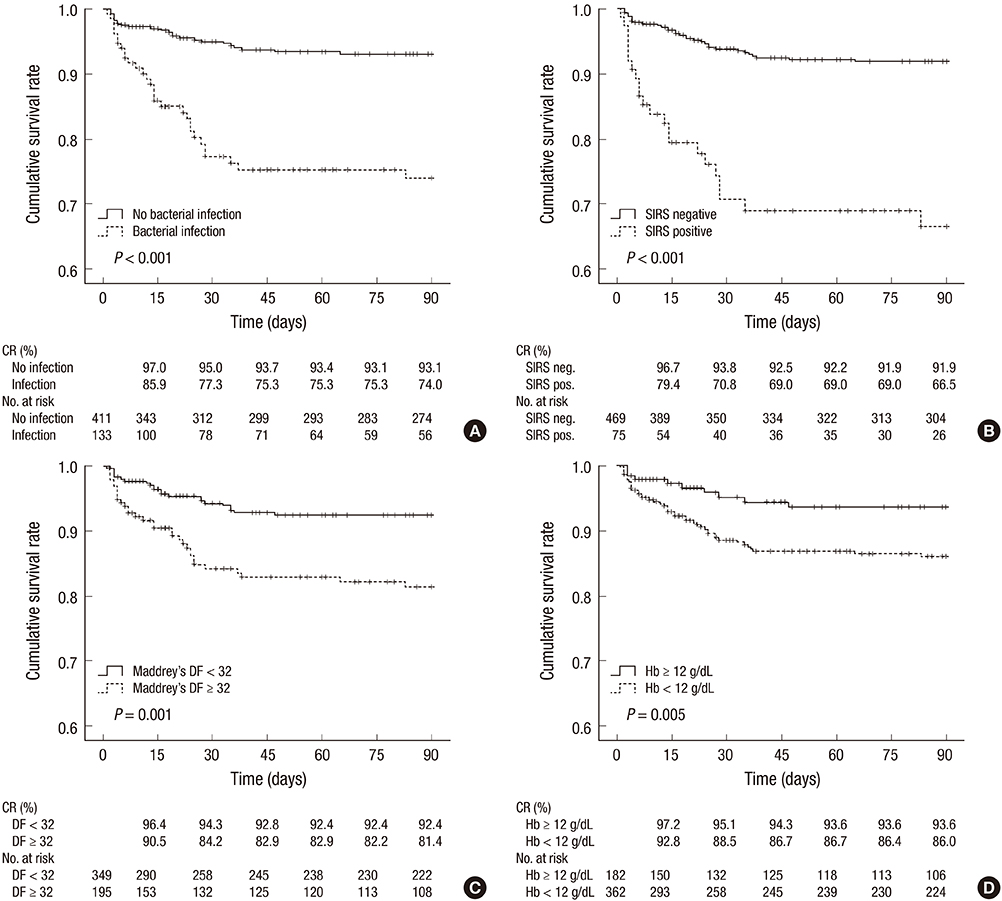J Korean Med Sci.
2015 May;30(5):598-605. 10.3346/jkms.2015.30.5.598.
Clinical Characteristics and Prognostic Impact of Bacterial Infection in Hospitalized Patients with Alcoholic Liver Disease
- Affiliations
-
- 1Department of Internal Medicine, Research Institute of Clinical Medicine, Chonbuk National University Medical School and Hospital, Jeonju, Korea. ihkimmd@jbnu.ac.kr
- KMID: 2155473
- DOI: http://doi.org/10.3346/jkms.2015.30.5.598
Abstract
- Bacterial infection is an important cause of death in patients with liver cirrhosis. The aim of this study was to investigate the clinical characteristics and prognostic impact of bacterial infection in hospitalized patients with alcoholic liver disease (ALD). We retrospectively analyzed data from 409 patients consecutively admitted to a tertiary referral center with ALD diagnosis. Of a total of 544 admissions, 133 (24.4%) cases presented with bacterial infection, of which 116 were community-acquired whereas 17 were hospital-acquired. The common types of infection were pneumonia (38%), biliary tract infection (17%), soft tissue infection (12%), and spontaneous bacterial peritonitis (9%). Diabetes, serum Na <135 mM/L, albumin <2.5 g/dL, C-reactive protein > or =20 mg/L, systemic inflammatory response syndrome (SIRS) positivity were independently associated with bacterial infection in patients with ALD. Overall 30-day and 90-day mortalities in patients with bacterial infection were significantly (P < 0.001) higher than those without infection (22.3% vs. 5.1% and 32.3% vs. 8.2%, respectively). Furthermore, bacterial infection (HR, 2.2; 95% CI, 1.049-4.579, P = 0.037), SIRS positivity (HR, 2.5; 95% CI, 1.240-4.861, P = 0.010), Maddrey's discriminant function score > or =32 (HR, 2.3; 95% CI, 1.036-5.222, P = 0.041), and hemoglobin <12 g/dL (HR, 2.4; 95% CI, 1.081-5.450, P = 0.032) were independent predictors of short-term mortality. In conclusion, bacterial infection and SIRS positivity predicted short-term prognosis in hospitalized patients with ALD. A thorough evaluation at admission or on clinical deterioration is required to detect possible infection with prompt management.
MeSH Terms
-
Adult
Aged
Bacterial Infections/complications/*diagnosis/mortality
C-Reactive Protein/analysis
Candida/isolation & purification
Female
Gram-Negative Bacteria/isolation & purification
Gram-Positive Bacteria/isolation & purification
Hemoglobins/analysis
Hospitalization
Humans
Linear Models
Liver Diseases, Alcoholic/complications/*diagnosis
Male
Middle Aged
Patients
Prognosis
Proportional Hazards Models
Retrospective Studies
Risk Factors
Serum Albumin/analysis
Sodium/blood
Survival Analysis
Systemic Inflammatory Response Syndrome/complications/diagnosis
Tertiary Care Centers
C-Reactive Protein
Hemoglobins
Serum Albumin
Sodium
Figure
Reference
-
1. Mandayam S, Jamal MM, Morgan TR. Epidemiology of alcoholic liver disease. Semin Liver Dis. 2004; 24:217–232.2. KASL clinical practice guidelines: management of alcoholic liver disease. Clin Mol Hepatol. 2013; 19:216–254.3. Yim HJ, Kim DJ, Kim JH, Heo J, Woo HY, Bae SH, Lee BS, Kim MW, Yang JM, Han SY, et al. Prognosis of patients with alcoholic liver disease in Korea: Comparisons of prognostic models by a national-wide survey. Hepatol Int. 2013; 7:S44.4. Rao R. Endotoxemia and gut barrier dysfunction in alcoholic liver disease. Hepatology. 2009; 50:638–644.5. Bonnel AR, Bunchorntavakul C, Reddy KR. Immune dysfunction and infections in patients with cirrhosis. Clin Gastroenterol Hepatol. 2011; 9:727–738.6. Arvaniti V, D'Amico G, Fede G, Manousou P, Tsochatzis E, Pleguezuelo M, Burroughs AK. Infections in patients with cirrhosis increase mortality four-fold and should be used in determining prognosis. Gastroenterology. 2010; 139:1246–1256. 1256.e1–1256.e5.7. Christou L, Pappas G, Falagas ME. Bacterial infection-related morbidity and mortality in cirrhosis. Am J Gastroenterol. 2007; 102:1510–1517.8. Runyon BA. Bacterial infections in patients with cirrhosis. J Hepatol. 1993; 18:271–272.9. Jalan R, Fernandez J, Wiest R, Schnabl B, Moreau R, Angeli P, Stadlbauer V, Gustot T, Bernardi M, Canton R, et al. Bacterial infections in cirrhosis: a position statement based on the EASL Special Conference 2013. J Hepatol. 2014; 60:1310–1324.10. Caly WR, Strauss E. A prospective study of bacterial infections in patients with cirrhosis. J Hepatol. 1993; 18:353–358.11. Yoshida H, Hamada T, Inuzuka S, Ueno T, Sata M, Tanikawa K. Bacterial infection in cirrhosis, with and without hepatocellular carcinoma. Am J Gastroenterol. 1993; 88:2067–2071.12. Fernández J, Navasa M, Gómez J, Colmenero J, Vila J, Arroyo V, Rodés J. Bacterial infections in cirrhosis: epidemiological changes with invasive procedures and norfloxacin prophylaxis. Hepatology. 2002; 35:140–148.13. Fernández J, Acevedo J, Castro M, Garcia O, de Lope CR, Roca D, Pavesi M, Sola E, Moreira L, Silva A, et al. Prevalence and risk factors of infections by multiresistant bacteria in cirrhosis: a prospective study. Hepatology. 2012; 55:1551–1561.14. Rosa H, Silvério AO, Perini RF, Arruda CB. Bacterial infection in cirrhotic patients and its relationship with alcohol. Am J Gastroenterol. 2000; 95:1290–1293.15. Cazzaniga M, Dionigi E, Gobbo G, Fioretti A, Monti V, Salerno F. The systemic inflammatory response syndrome in cirrhotic patients: relationship with their in-hospital outcome. J Hepatol. 2009; 51:475–482.16. Thabut D, Massard J, Gangloff A, Carbonell N, Francoz C, Nguyen-Khac E, Duhamel C, Lebrec D, Poynard T, Moreau R. Model for end-stage liver disease score and systemic inflammatory response are major prognostic factors in patients with cirrhosis and acute functional renal failure. Hepatology. 2007; 46:1872–1882.17. Tsiakalos A, Karatzaferis A, Ziakas P, Hatzis G. Acute-phase proteins as indicators of bacterial infection in patients with cirrhosis. Liver Int. 2009; 29:1538–1542.18. Papp M, Vitalis Z, Altorjay I, Tornai I, Udvardy M, Harsfalvi J, Vida A, Kappelmayer J, Lakatos PL, Antal-Szalmas P. Acute phase proteins in the diagnosis and prediction of cirrhosis associated bacterial infections. Liver Int. 2012; 32:603–611.19. Lazzarotto C, Ronsoni MF, Fayad L, Nogueira CL, Bazzo ML, Narciso-Schiavon JL, de Lucca Schiavon L, Dantas-Corrêa EB. Acute phase proteins for the diagnosis of bacterial infection and prediction of mortality in acute complications of cirrhosis. Ann Hepatol. 2013; 12:599–607.20. Li CH, Yang RB, Pang JH, Chang SS, Lin CC, Chen CH, Chen HY, Chiu TF. Procalcitonin as a biomarker for bacterial infections in patients with liver cirrhosis in the emergency department. Acad Emerg Med. 2011; 18:121–126.21. Katoonizadeh A, Laleman W, Verslype C, Wilmer A, Maleux G, Roskams T, Nevens F. Early features of acute-on-chronic alcoholic liver failure: a prospective cohort study. Gut. 2010; 59:1561–1569.22. Gonzalez-Casas R, Jones EA, Moreno-Otero R. Spectrum of anemia associated with chronic liver disease. World J Gastroenterol. 2009; 15:4653–4658.
- Full Text Links
- Actions
-
Cited
- CITED
-
- Close
- Share
- Similar articles
-
- Comparison of bacterial infection rate between patients with alcoholic liver cirrhosis and viral liver cirrhosis
- The comparison of bacterial infection rate in the patients with alcoholic and viral cirrhosis
- Should you advocate for hepatocellular carcinomasurveillance in patients with alcohol-related liverdisease or non-alcoholic fatty liver disease?
- Psychosocial Characteristics of Patients with Alcoholic Liver Disease
- Host-Microbiome Interactions in Alcoholic Liver Disease



